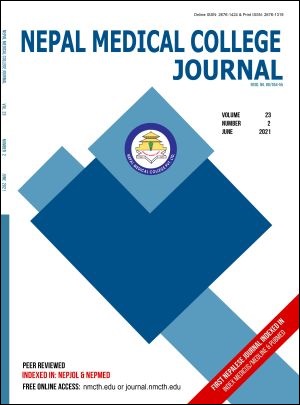Bacteriological Examination of Water supply and Drinking Water at Household level in Makalbari Area by the Most Probable Number Method
DOI:
https://doi.org/10.3126/nmcj.v23i2.38525Keywords:
Coliform bacteria, drinking water, most probable number (MPN) method, KathmanduAbstract
Water safety and quality are fundamental to human development and well-being. Yet, at least 2 billion people are using a drinking water source contaminated with feces worldwide. This study was conducted to assess the types of water supply, storage and methods of purification of drinking water and to examine the bacteriological quality of supplied and drinking water at household level by most probable number (MPN) test in Makalbari area in Gokarneshwor Municipality, Kathmandu. A total of 80 households were selected using simple random sampling technique and two samples (one from main water supply and another from drinking water, n=160 water samples) were collected from each household. Ethical clearance was taken from the Nepal Medical College Institutional Review Committee. SPSS version 16.0 was used for statistical analysis. Majority of water supply samples 65 (81.2%) were from tap, 11 (13.8%) were from well and 4 (5.0%) samples were from bore well. Bacteriologically, of the total water supply samples, 34 (42.5%) samples were excellent, 16 (20.0%) samples were suspicious and 30 (37.5%) samples were unsatisfactory by MPN index quality. Most of the households stored drinking water in the tanks 34 (42.5%). Most of the water samples 29 (36.3%) were directly consumed from the water supply without purification. Among the directly consumed drinking water samples, 13 (44.8%) samples showed unsatisfactory MPN index. Most commonly used methods of water purification was filtration 21 (26.2%). Of the total drinking water samples, 33 (41.25%) samples were positive for total coliform. Thirty-two (40.0%) of the households reported diarrhea in past one year. A highly significant association was found between MPN index of drinking water and occurrence of diarrhea in the households. The quality of the most of the water samples from water supply and drinking water were unsatisfactory. Inspite of this, drinking water was not purified in some of the households. Moreover, few of the drinking water samples were not potable even after purification. Therefore, community should be made aware to improve quality of drinking water in households.
Downloads
Downloads
Published
How to Cite
Issue
Section
License
Copyright (c) 2021 Nepal Medical College Journal

This work is licensed under a Creative Commons Attribution 4.0 International License.
This license enables reusers to distribute, remix, adapt, and build upon the material in any medium or format, so long as attribution is given to the creator. The license allows for commercial use.




